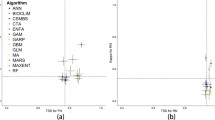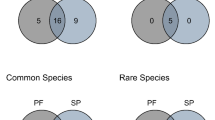Summary
Electivity indices measure the utilization of food types (r) in relation to their abundance or availability in the environment (p). Foods that constitute a larger proportion of the diet than of the available foods are considered preferred; conversely those proportionately underrepresented in the diet are avoided. A food is eaten at random if its proportion in the diet equals its proportion in the environment. A family of electivity indices stemming from Ivlev's (1961) classic monograph exist and differ only in the particular algorithm used to calculate electivity from r and p.
For each available index I graphed the values of electivity as contours for all combinations of r and p. These graphs are compared to illustrate the strengths and weaknesses of each index on the basis of the following criteria: 1) the value of the index when r=p for a food, 2) the symmetry of the electivity value as feeding deviates from random, 3) the possible range of index values, 4) the linearity of changes in electivity over the full range of r and p, 5) the sensitivity of the index to sampling errors, 6) the statistical testability of the electivity, and 7) the stability of the electivity value for a food type that changes relative abundance or occurs in combination with different food types. No one index ideally satisfies all the criteria.
The host preferences of gypsy moth, Lymantria dispar, feeding on tree foliage in an undisturbed deciduous forest in southwestern Quebec, Canada were used to compare the available indices: Ivlev's electivity, E; Ivlev's forage ratio, E'; Jacob's modified electivity, D; Jacob's modified forage ratio, log Q; Chesson's alpha; Strauss' linear index, L; and Vanderploeg and Scavia's relativized electivity, E *. The electivity values calculated by each index differ one from another; host trees shown as preferred by one index will frequently appear avoided according to an alternative index. The rank order electivities for the 19 available host trees, however, are remarkably similar for all but Strauss' linear index, L. Populus grandidentata, Quercus rubra, Ostrya virginiana, and Amelanchier were the most preferred host trees in the sampled forest; Prunus serotina, Acer pensylvanicum, A. rubrum, Betula lutea, and Fraxinus americana were most avoided. The use of Vanderploeg and Scavia's E * index is recommended.
Similar content being viewed by others
References
Barbosa P (1978) Host plant exploitation by the gypsy moth, Lymantria dispar. Ent Exp Appl 24:28–37
Campbell RW, Sloan RJ (1977) Forest stand responses to defoliation by the gypsy moth. Forest Science Monograph 19 34 pages
Campbell RW, Levitan LC, Sobecki ER, Tardiff MF (1978) Population dynamics of the gypsy moth: an annotated bibliography. USDA Forest Service, General Technical Report NE-48
Chesson J (1978) Measuring preference in selective predation. Ecology 59:211–215
Cock MJW (1978) The assessment of preference. J Anim Ecol 47:805–816
Doane CC (1976) Flight and mating behavior of the gypsy moth, pages 127–136. In: JF Anderson, HK Kaya, (eds), Perspectives in forest entomology. Academic Press, NY
Downing JA (1981) In situ foraging responses of three species of littoral cladocerans. Ecol Monog 51:85–103
Erlinge S (1981) Food preference, optimal diet and reproductive output in stoats, Mustela erminea, in Sweden. Oikos 36:303–315
Forbush EH, Fernald CH (1896) The gypsy moth. Wright and Potter, Boston
Griffiths KJ (1980) A bibliography of gypsy moth literature. Can For Service, Sault Ste Marie, Ontario Report 0-X-312
Ivlev VS (1961) Experimental ecology of the feeding of fishes. Yale University Press, New Haven, Connecticut
Jacobs J (1974) Quantitative measurement of food selection. Oecologia (Berl) 14:413–417
Jenkins SH (1979) Seasonal and year-to-year differences in food selection by beavers. Oecologia (Berl) 44:112–116
Johnson DH (1980) The comparison of usage and availability measurements for evaluating resource preference. Ecology 61:65–71
Kitting, CL (1980) Herbivore-plant interactions of individual limpets maintaining a mixed diet of inter-tidal marine algae. Ecol Monog 50:527–550
Lechowicz MJ, Mauffette Y (1980) Feeding preferences of the gypsy moth (Lymantria dispar) in the forests of southern Quebec. Laurentian Forest Research Centre, Environment Canada, Ste. Foy, Quebec, unpublished research report
Leonard DE (1970) Feeding rhythm in larvae of the gypsy moth. J Econ Entom 63:1454–1457
Leonard DE (1971) Air-borne dispersal of larvae of the gypsy moth and its influence on concepts of control. J Econ Ent 64:638–641
Little EL Jr (1971) Atlas of United States trees. Vol 1. Conifers and important hardwoods. USDA Forest Service, Miscellaneous Publication 1146, Washington, DC
Madgwick HAI (1970) Biomass and productivity models of forest canopies, pp 47–54. In: DE Reichle (ed), Analyses of temperate forest ecosystems. Springer-Berlin Heidelberg New York
Maycock PF (1961) Botanical studies on Mont St. Hilaire, Rouville County, Quebec. Can J Bot 39:1293–1325
Mosher FH (1915) Food plants of the gypsy moth in America. USDA Bulletin 250, Washington, DC pages 39
Newsome GE, Gee JH (1978) Preference and selection of prey by creek chub, Semotilus atromaculatus, inhabiting the Mink River, Manitoba. Can J Zool 56:2486–2497
Paloheimo JE (1979) Indices of food preference by a predator. J Fish Res Board Can 36:470–473
Pyke GH, Pulliam HR, Charnov EL (1977) Optimal foraging: a selective review of theory and tests. Quar Rev Biol 52:137–154
Reynolds HT (1977) The analysis of cross-classifications. Free Press, NY
Rossiter MC (1980) Enhanced pathogen resistance as a result of a host shift by the gypsy moth. Second International Congress of Systematic and Evolutionary Biology, Vancouver, British Columbia. Abstracts: p 328
Siegel S (1956) Nonparametric statistics for the behavioral sciences. McGraw Hill, NY
Skogland T (1980) Comparative summer feeding strategies of arctic and alpine rangifer. J Anim Ecology 49:81–98
Sokal RR, Rohlf FJ (1969) Biometry: the principles and practice of statistics in biological research. Freeman, San Francisco
Strauss RE (1979) Reliability estimates for Ivlev's electivity index, the forage ratio, and a proposed linear index of food selection. Trans Am Fish Soc 108:344–352
Vanderploeg HA, Scavia D (1979a) Two electivity indices for feeding with special reference to zooplankton grazing. J. Fish Res Board Can 36:362–365
Vanderploeg HA, Scavia D (1979b) Calculation and use of selectivity coefficients of feeding: zooplankton grazing. Ecol Modelling 7:135–149
Weseloh RM (1974) Relationships between different sampling procedures for the gypsy moth, Porthetria dispar (Lepidoptera: Lymantriidae) and its natural enemies. Can Ent 106:225–231
Whittaker RH, Marks PL (1975) Methods of assessing terrestrial productivity, pp 5–118. In: H Lieth and RH Whittaker (eds) Primary productivity of the biosphere. Springer-Berlin Heidelberg New York
Author information
Authors and Affiliations
Rights and permissions
About this article
Cite this article
Lechowicz, M.J. The sampling characteristics of electivity indices. Oecologia 52, 22–30 (1982). https://doi.org/10.1007/BF00349007
Received:
Issue Date:
DOI: https://doi.org/10.1007/BF00349007




